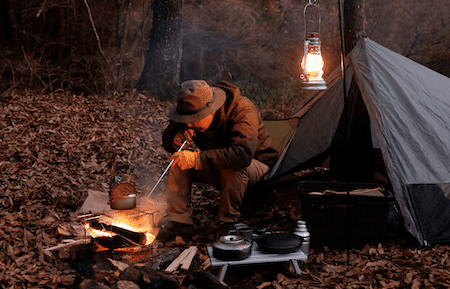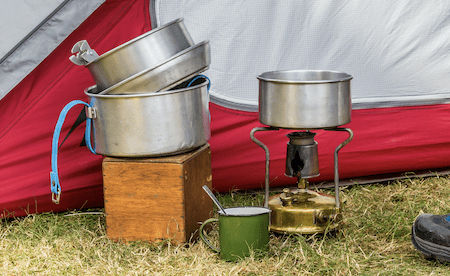While you are out camping for days, it is not possible to solely depend on dry foods. Also camping far from civilization means you have no access to shops either. So, camping out means you have to cook your own food.
If the sky is clear and the wind is not bothering you, cooking at campfires is a fun activity. However, windy and rainy weather makes it impossible sometimes. So, you might be forced to cook in your tent.
Now you might be curious about “How to safely cook in a tent?” Because you might face situations where you need to know about the dangers and safe options of cooking in a tent.
In this article, we will cover all the necessary aspects of cooking in a tent in detail. So, stay tuned till the end!
Things You Need To Know Before Cooking In Tents
If you want to deal with the dangers of cooking in a tent, you need to be aware of the dangers of this activity first. So, there are a few things you should know about before you start applying your cooking skills in a tent.
#1. Tent Catching Fire
Tents catching fire is a concern of many. People are extra careful around camps with fires and it is a precaution that is needed. It is because most camps are made from materials like nylon and polyester. They are extremely flammable.
Now you might say that most of the time camping tents have flame retardants. There are a few kinds of retardants, some might make the tent flame-resistant or make the flame spread slowly. This does not make the tent completely safe.
These flame retardants might not be present in cheap tents and the ones made for backyard camping. So, check the tags before you purchase a tent. However, buying a fire-resistant tent does not mean you can cook carelessly in your tent.
Always remember they are fire-resistant not fireproof. Are there any fireproof tents in the market? The answer is no. They come with fire retardants and that’s it. The fire retardant chemicals that are available in the tent are also harmful to humans if exposed to large quantities of it.
Though there is a minuscule amount of it present in the tents to make them fire-resistant. It will not harm you but be sure to wash your hands thoroughly after you set up your tent.
#2. Burning Yourself
While cooking, we are always careful in the kitchen. Being careful is more important when you are cooking in an enclosed space, like in a tent. While cooking in a tent the fire needs to be under control at all times.
The fuel that you use will decide how strong the flame is. For tents, I believe you are better off with slow and controlled fire. It might take longer for you to cook but you will be much safer. Fuel plays an important role in controlling flames.
You never should use woods in a tent because woods create the most unpredictable fire. They are not consistent at all and can become risky for you. The other fuel you should avoid is white gas, it can leak and you would not even know. So, it can create some dangerous situations.
The safer options are propane and butane. They come in small canisters and they are quite safe. Fuels that can spill like kerosene should also be avoided because spilling them in the tent is a recipe for disaster.
However, if you get burned, cool the affected area quickly. Applying water for 10 minutes should help. Then apply lotions and bandage the burn. The bandage should be loose and these steps only apply for minor burns.
#3. Carbon Monoxide
Carbon monoxide is created by burning any kind of carbon-based materials. However, with the presence of oxygen in the air, they turn into Carbon dioxide. But for enclosed spaces like tents, that is not the case.
Carbon monoxide in large quantities is harmful to most animals including us. It can suffocate and can cause brain damage. The scariest part is the gas is odorless and colorless. So, you would not know that you are in a pit of Carbon monoxide until it is too late.
So, while you cook in a tent you need to have good ventilation. Make sure to open the door and windows in your tents. The more air the better. You can cook in the tent vestibule because it offers more ventilation and has good cover from the outside weather too.
So, always remember ventilation is the key when you are cooking inside a tent. Even if you cannot fully open the door in bad weather, keep them half-opened. There have been cases where people kept their stoves burning at night for warmth and met with an unfortunate death.
Necessary Equipment For Cooking In Tents
There are a few pieces of equipment you cannot do without if you want your cooking experience to be great while camping. The first one is obviously a good stove.
The stoves nowadays are quite good but there are stoves that are also windproof. These stoves can be your friend in windy and rough weather. They also tend to be fuel-efficient and effective for cooking good meals.
We will talk about a few of these windproof stoves and about what they can offer you.
#1. The MSR Reactor
The MSR reactor is a stove that was designed for rough weather. It was originally designed as a tool for alpinists. It is windproof and with reactor technology, it can generate heat very quickly.
The materials that are used to make these stoves are also top-shelf. So, they are effective and durable at the same time. It has a compact design with the fuel tank and pot all fitting together. They are priced at 249.95 dollars and once were the only windproof stove in the market.
#2. The Texsport Single Burner Propane Stove
The Texsport single burner propane stove is a cheaper option than the MSR reactor. It is a small stove but with big capabilities. The stove is backpack friendly and fuel-efficient.
However, it is not that durable but compared to the price works excellently. The stove functions in snowy, windy situations without fail. If you are looking for windproof stoves that will not break the bank this is a good option.
#3. The MSR Windburner
This is another stove from MSR. The MSR windburner caters more to the campers. This stove is the all-in-one solution you need. It has the same technology as the MSR reactor but it produces less heat.
Less heat does not mean it is bad. The reactor is designed for snowy mountains while the windburner is for traditional camping. The windburner also has more options for pots. It supports many kinds of pots, unlike the reactor.
If you own one of these you do not need any other camping stoves. They are priced at 127.39 dollars, which is much cheaper than the reactor.
#4. Trekmate Flameless Cooking Kit
Trekmate has a line of cooking kit that does not need any fire. Instead of fire, they use heat pads. When these heat pads come into contact with water, produce heat that can cook your meals.
However, the heat is not enough if you are thinking of cooking extravagant or large meals. The heat they produce is enough to whip up some simple stuff like pasta, rice, etc. They also have heat flasks that can warm your drinks quickly.
The drawback is that you have to purchase the heat pads from Trekmate and if you run out of them the kit is useless. The whole kit is priced at 24 dollars and you can purchase heat pads for 5 dollars apiece.
Frequently Asked Questions
#1. Should I Cook In Tents Without Emergencies?
Cooking in tents should only be done if it’s a necessity. If you have options to cook outside the tent, never cook inside the tent.
There are many things that can go wrong and you have to be very careful too. So, if there are no emergencies you should not cook in tents.
#2. Can I Cook Outside In Rough Weather With The Windproof Stoves?
You can actually cook outside with the windproof stoves in windy, stormy weather. Though the stove will save your cooking, it will not keep you safe. So, get your stove in the shelter and keep the tent ventilated.
Also always be careful while cooking in a tent, even if you have all the necessary gear and equipment.
#3. Does Cooking In A Tent Attract Wildlife?
If you are using raw meats, and fish it certainly will attract wildlife. The raw smell is very strong and animals have noses that are made to pick up those odors. So, bring processed or canned protein.
They are already cooked to a certain degree and will not smell strongly like raw products.
Conclusion
Cooking in a tent should only be done in emergencies. If you have the option to cook outside, always choose outside. It is only an option when you have the necessity for it.
Also, try to go camping in suitable weather. If the weather forecast is saying the weather is not favorable for camping, staying inside is the best option.
And if you are at the end of the article you should know how to safely cook in a tent. So, happy camping and safe cooking!


